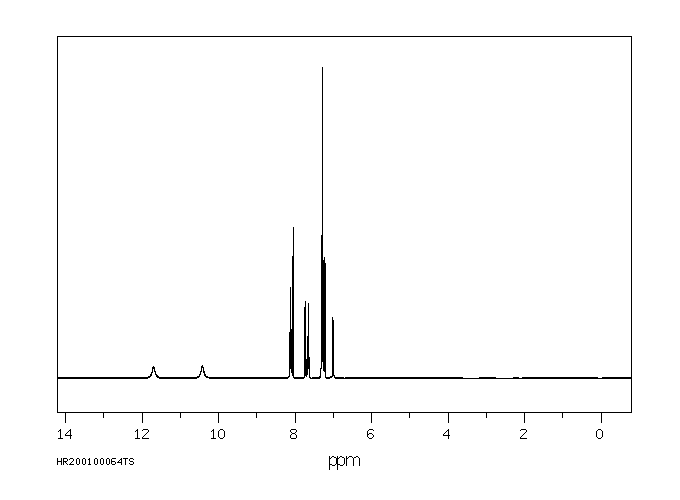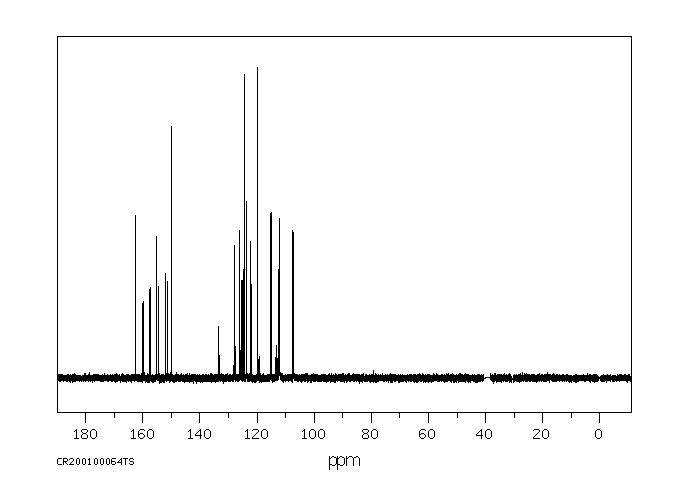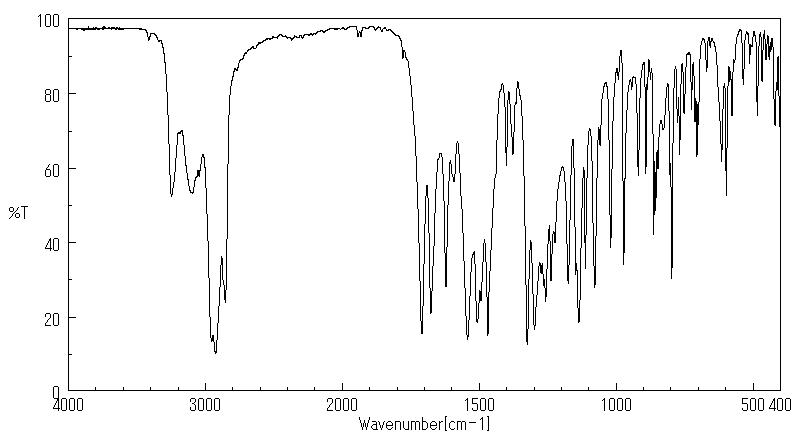氟虫脲 | 101463-69-8
-
物化性质
-
计算性质
-
ADMET
-
安全信息
-
SDS
-
制备方法与用途
-
上下游信息
-
文献信息
-
表征谱图
-
同类化合物
-
相关功能分类
-
相关结构分类
物化性质
-
熔点:169-172° (dec)
-
密度:1.5123 (estimate)
-
溶解度:可溶于苯(轻微加热)、DMSO(轻微)、乙酸乙酯(少量)
-
颜色/状态:Colorless crystals
-
气味:Odorless
-
蒸汽压力:6.52X10-9 mPa /SRC: 4.89X10-14 mm Hg/ at 20 °C
-
分解:When heated to decomposition it emits toxic vapors of /nitrogen oxides, hydrogen fluoride and hydrogen chloride/.
-
解离常数:pKa = 10.1 (calc)
-
碰撞截面:204.46 Ų [M+H]+ [CCS Type: TW]
-
稳定性/保质期:
在常温常压下,该物质是稳定的。
计算性质
-
辛醇/水分配系数(LogP):6.3
-
重原子数:33
-
可旋转键数:4
-
环数:3.0
-
sp3杂化的碳原子比例:0.047
-
拓扑面积:67.4
-
氢给体数:2
-
氢受体数:9
ADMET
安全信息
-
危险等级:9
-
危险品标志:Xn
-
安全说明:S22
-
危险类别码:R20
-
WGK Germany:2
-
危险品运输编号:3077
-
RTECS号:CV2474500
-
包装等级:III
-
危险类别:9
SDS
模块 1. 化学品
1.1 产品标识符
: 氟虫脲
产品名称
1.2 鉴别的其他方法
N-{4-[2-Chloro-4-(trifluoromethyl)phenoxy]-2-fluorophenylaminocarbonyl}-2,6-difluoro-benzamide
1.3 有关的确定了的物质或混合物的用途和建议不适合的用途
仅用于研发。不作为药品、家庭或其它用途。
模块 2. 危险性概述
2.1 GHS-分类
急性毒性, 经口 (类别 5)
急性毒性, 吸入 (类别 4)
急性毒性, 经皮 (类别 5)
2.2 GHS 标记要素,包括预防性的陈述
象形图
警示词 警告
危险申明
H303 吞咽可能有害。
H313 接触皮肤可能有害。
H332 吸入有害。
警告申明
预防
P261 避免吸入粉尘/烟/气体/烟雾/蒸气/喷雾.
P271 只能在室外或通风良好之处使用。
响应
P304 + P340 如吸入: 将患者移到新鲜空气处休息,并保持呼吸舒畅的姿势。
P312 如感觉不适,呼救中毒控制中心或医生.
2.3 其它危害物 - 无
模块 3. 成分/组成信息
3.1 物 质
: N-{4-[2-Chloro-4-(trifluoromethyl)phenoxy]-2-fluorophenylaminocarbonyl}-
别名
2,6-difluoro-benzamide
: C21H11ClF6N2O3
分子式
: 488.77 g/mol
分子量
组分 浓度或浓度范围
Flufenoxuron
-
化学文摘登记号(CAS 101463-69-8
No.) 417-680-3
EC-编号
模块 4. 急救措施
4.1 必要的急救措施描述
一般的建议
请教医生。 向到现场的医生出示此安全技术说明书。
吸入
如果吸入,请将患者移到新鲜空气处。 如呼吸停止,进行人工呼吸。 请教医生。
皮肤接触
用肥皂和大量的水冲洗。 请教医生。
眼睛接触
用水冲洗眼睛作为预防措施。
食入
切勿给失去知觉者通过口喂任何东西。 用水漱口。 请教医生。
4.2 主要症状和影响,急性和迟发效应
4.3 及时的医疗处理和所需的特殊处理的说明和指示
无数据资料
模块 5. 消防措施
5.1 灭火介质
灭火方法及灭火剂
用水雾,抗乙醇泡沫,干粉或二氧化碳灭火。
5.2 源于此物质或混合物的特别的危害
碳氧化物, 氮氧化物, 氯化氢气体, 氟化氢
5.3 给消防员的建议
如必要的话,戴自给式呼吸器去救火。
5.4 进一步信息
无数据资料
模块 6. 泄露应急处理
6.1 作业人员防护措施、防护装备和应急处置程序
使用个人防护用品。 避免粉尘生成。 避免吸入蒸气、烟雾或气体。 保证充分的通风。 避免吸入粉尘。
6.2 环境保护措施
不要让产品进入下水道。
6.3 泄漏化学品的收容、清除方法及所使用的处置材料
收集和处置时不要产生粉尘。 扫掉和铲掉。 放入合适的封闭的容器中待处理。
6.4 参考其他部分
丢弃处理请参阅第13节。
模块 7. 操作处置与储存
7.1 安全操作的注意事项
避免接触皮肤和眼睛。 避免形成粉尘和气溶胶。
在有粉尘生成的地方,提供合适的排风设备。一般性的防火保护措施。
7.2 安全储存的条件,包括任何不兼容性
贮存在阴凉处。 使容器保持密闭,储存在干燥通风处。
7.3 特定用途
无数据资料
模块 8. 接触控制和个体防护
8.1 容许浓度
最高容许浓度
没有已知的国家规定的暴露极限。
8.2 暴露控制
适当的技术控制
根据良好的工业卫生和安全规范进行操作。 休息前和工作结束时洗手。
个体防护设备
眼/面保护
带有防护边罩的安全眼镜符合 EN166要求请使用经官方标准如NIOSH (美国) 或 EN 166(欧盟)
检测与批准的设备防护眼部。
皮肤保护
戴手套取 手套在使用前必须受检查。
请使用合适的方法脱除手套(不要接触手套外部表面),避免任何皮肤部位接触此产品.
使用后请将被污染过的手套根据相关法律法规和有效的实验室规章程序谨慎处理. 请清洗并吹干双手
所选择的保护手套必须符合EU的89/686/EEC规定和从它衍生出来的EN 376标准。
身体保护
全套防化学试剂工作服, 防护设备的类型必须根据特定工作场所中的危险物的浓度和数量来选择。
呼吸系统防护
如须暴露于有害环境中,请使用P95型(美国)或P1型(欧盟 英国
143)防微粒呼吸器。如需更高级别防护,请使用OV/AG/P99型(美国)或ABEK-P2型 (欧盟 英国 143)
防毒罐。
呼吸器使用经过测试并通过政府标准如NIOSH(US)或CEN(EU)的呼吸器和零件。
模块 9. 理化特性
9.1 基本的理化特性的信息
a) 外观与性状
形状: 结晶
颜色: 灰白色或米色
b) 气味
无数据资料
c) 气味阈值
无数据资料
d) pH值
无数据资料
e) 熔点/凝固点
169 - 172 °C
f) 沸点、初沸点和沸程
无数据资料
g) 闪点
无数据资料
h) 蒸发速率
无数据资料
i) 易燃性(固体,气体)
无数据资料
j) 高的/低的燃烧性或爆炸性限度 无数据资料
k) 蒸气压
无数据资料
l) 蒸汽密度
无数据资料
m) 密度/相对密度
无数据资料
n) 水溶性
无数据资料
o) n-辛醇/水分配系数
无数据资料
p) 自燃温度
无数据资料
q) 分解温度
无数据资料
r) 粘度
无数据资料
模块 10. 稳定性和反应活性
10.1 反应性
无数据资料
10.2 稳定性
无数据资料
10.3 危险反应
无数据资料
10.4 应避免的条件
无数据资料
10.5 不相容的物质
无数据资料
10.6 危险的分解产物
其它分解产物 - 无数据资料
模块 11. 毒理学资料
11.1 毒理学影响的信息
急性毒性
半数致死剂量 (LD50) 经口 - 大鼠 - > 3,000 mg/kg
半数致死浓度(LC50) 吸入 - 大鼠 - 4 h - 5,000 mg/m3
半数致死剂量 (LD50) 经皮 - 大鼠 - > 2,000 mg/kg
皮肤刺激或腐蚀
无数据资料
眼睛刺激或腐蚀
无数据资料
呼吸道或皮肤过敏
无数据资料
生殖细胞突变性
无数据资料
致癌性
IARC:
此产品中没有大于或等于 0。1%含量的组分被 IARC鉴别为可能的或肯定的人类致癌物。
生殖毒性
无数据资料
特异性靶器官系统毒性(一次接触)
无数据资料
特异性靶器官系统毒性(反复接触)
无数据资料
吸入危险
无数据资料
潜在的健康影响
吸入 吸入有害。 可能引起呼吸道刺激。
摄入 如服入是有害的。
皮肤 通过皮肤吸收可能有害。 可能引起皮肤刺激。
眼睛 可能引起眼睛刺激。
附加说明
化学物质毒性作用登记: CV2474500
模块 12. 生态学资料
12.1 生态毒性
无数据资料
12.2 持久性和降解性
无数据资料
12.3 潜在的生物累积性
无数据资料
12.4 土壤中的迁移性
无数据资料
12.5 PBT 和 vPvB的结果评价
无数据资料
12.6 其它不良影响
无数据资料
模块 13. 废弃处置
13.1 废物处理方法
产品
将剩余的和不可回收的溶液交给有许可证的公司处理。
联系专业的拥有废弃物处理执照的机构来处理此物质。
与易燃溶剂相溶或者相混合,在备有燃烧后处理和洗刷作用的化学焚化炉中燃烧
受污染的容器和包装
按未用产品处置。
模块 14. 运输信息
14.1 联合国危险货物编号
欧洲陆运危规: - 国际海运危规: - 国际空运危规: -
14.2 联合国运输名称
欧洲陆运危规: 非危险货物
国际海运危规: 非危险货物
国际空运危规: 非危险货物
14.3 运输危险类别
欧洲陆运危规: - 国际海运危规: - 国际空运危规: -
14.4 包裹组
欧洲陆运危规: - 国际海运危规: - 国际空运危规: -
14.5 环境危险
欧洲陆运危规: 否 国际海运危规 国际空运危规: 否
海洋污染物(是/否): 否
14.6 对使用者的特别提醒
无数据资料
模块 15 - 法规信息
N/A
模块16 - 其他信息
N/A
制备方法与用途
氟虫脲属于苯甲酰脲类杀虫杀螨剂,兼具触杀和胃毒双重作用。它通过抑制昆虫表皮几丁质的合成,使昆虫无法正常蜕皮或变态而死亡。成虫接触药后,产下的卵即使孵化出的幼虫也会迅速死亡。氟虫脲对叶螨属和全爪螨属等多种害螨的幼螨杀伤效果显著,虽然不能直接杀死成螨,但能减少雌成螨的产卵量并导致不育现象。此外,它还对叶螨天敌安全,并具有明显的拒食作用。
毒性氟虫脲的大鼠急性经口LD₅₀大于3000 mg/kg,大鼠急性经皮LD₅₀大于2000 mg/kg,大鼠急性吸入LC₅₀大于5 mg/L,静脉注射LD₅₀大于1500 mg/kg。对兔眼睛和皮肤无刺激作用。大鼠饲喂试验的无作用剂量为50 mg/kg饲料(3个月),狗为100 mg/kg饲料(12个月),兔亚急性经口无作用剂量大于500 mg/kg。动物实验未发现致畸、致突变作用,对鲑鱼LC₅₀大于100 mg/L(24小时)。但对家蚕毒性较大。
生物活性Flufenoxuron 是几丁质合成抑制剂,可用作苯甲酰脲类杀虫剂。它通过减少甲壳素的合成,阻止蜕皮和卵孵化,从而防止昆虫发育。
化学性质纯品为白色结晶状固体,熔点在169~172℃(分解),蒸汽压为4.55×10⁻¹² Pa (20°C)。溶解度如下:丙酮82 g/L (25°C),二氯甲烷24 g/L (25°C),二甲苯6 g/L (20°C),己烷0.023 g/L (20°C)(不溶于水)。分配系数为12600(pH值7)。在自然日光照射下,水中半衰期为11天;在25℃时,水解反应的半衰期分别为:pH值5时206天、pH值7时267天、pH值9时36.7天和pH值12时2.7天。氟虫脲对光、热稳定。
用途氟虫脲是一种苯甲酰脲类昆虫生长调节剂,属壳多糖酶抑制剂,具有杀螨与杀虫兼治的特点,活性高且持效期长。该药剂还表现出良好的叶面滞留性。它通过触杀和胃毒作用,但无内吸作用,能够阻止害虫正常蜕皮和变态而逐渐死亡。可用于防治柑橘、大豆、果树、棉花、蔬菜和玉米等作物田间成熟阶段的螨类和昆虫,并对捕食性螨和昆虫安全。用于防治菜青虫、菜螟和小菜蛾等,在卵孵盛期至1~2龄幼虫盛发期,可使用5%乳油2000~4000倍液喷雾。在棉花红蜘蛛发生初期,可用5%乳油1000~2000倍液喷雾。
用途 生产方法 4-(4-三氟甲基-2-氯苯氧基)-2-氟苯胺的制备在氢氧化钾存在下,将3,4-二氯三氟甲苯与2-氟-4-羟基苯胺于二甲亚砜溶剂中反应,制得目标产物。
2,6-二氟苯甲酰异氰酸酯的制备 方法一将2,6-二氟苯甲酰胺与草酰氯在二氯甲烷为溶剂的情况下进行回流反应24小时,从而制得2,6-二氟苯甲酰异氰酸酯。
方法二或使用光气作为试剂,在50℃下以二氯乙烷为溶剂的条件下反应1小时来制备目标产物。
氟虫脲合成上下游信息
-
下游产品
中文名称 英文名称 CAS号 化学式 分子量 —— 4-(2-chloro-4-(trifluoromethyl)-phenoxy)-2-fluoroaniline 101463-63-2 C13H8ClF4NO 305.659
反应信息
-
作为反应物:参考文献:名称:Development of a Compound-Specific ELISA for Flufenoxuron and an Improved Class-Specific Assay for Benzoylphenylurea Insect Growth Regulators摘要:This study describes immunochemical approaches for the compound-specific detection of flufenoxuron and class-specific detection of benzoylphenylurea (BPU) insecticides. With the aim of developing a highly specific immunoassay for flufenoxuron, a hapten was synthesized by introducing a spacer arm at the 2,6-difluoro substituent aromatic ring of a flufenoxuron derivative. An IC50 value of 2.4 ppb was obtained for flufenoxuron, with detection of the other four BPUs being more than 4000-fold less sensitive. For the development of class-specific ELISA for five BPUs, a new approach was used for the hapten preparation in which a butanoic acid linkage was introduced into the 3,5-dichloro-substitued aniline ring of chlorfluazuron analogue. Although the resultant ELISA still exhibited slightly differing cross-reactions for these five BPUs, this method had broader specificity than the previously reported polyclonal antibody-based ELISA. Spike and recovery studies for five BPUs in soil and water indicated that both the compound- and class-specific ELISAs were able to quantitatively detect BPU residues in soil and water. This study also provided additional insights into the influence of the immunizing hapten structure on the specificities of the antibodies obtained.DOI:10.1021/jf9812984
文献信息
-
[EN] ACC INHIBITORS AND USES THEREOF<br/>[FR] INHIBITEURS DE L'ACC ET UTILISATIONS ASSOCIÉES
-
[EN] BICYCLYL-SUBSTITUTED ISOTHIAZOLINE COMPOUNDS<br/>[FR] COMPOSÉS ISOTHIAZOLINE SUBSTITUÉS PAR UN BICYCLYLE申请人:BASF SE公开号:WO2014206910A1公开(公告)日:2014-12-31The present invention relates to bicyclyl-substituted isothiazoline compounds of formula (I) wherein the variables are as defined in the claims and description. The compounds are useful for combating or controlling invertebrate pests, in particular arthropod pests and nematodes. The invention also relates to a method for controlling invertebrate pests by using these compounds and to plant propagation material and to an agricultural and a veterinary composition comprising said compounds.本发明涉及公式(I)中变量如索权和说明中所定义的自行车基取代异噻唑啉化合物。这些化合物对抗或控制无脊椎动物害虫,特别是节肢动物害虫和线虫方面具有用途。该发明还涉及一种通过使用这些化合物来控制无脊椎动物害虫的方法,以及包含所述化合物的植物繁殖材料、农业和兽医组合物。
-
[EN] AZOLINE COMPOUNDS<br/>[FR] COMPOSÉS AZOLINE申请人:BASF SE公开号:WO2015128358A1公开(公告)日:2015-09-03The present invention relates to azoline compounds of formula (I) wherein A, B1, B2, B3, G1, G2, X1, R1, R3a, R3b, Rg1 and Rg2 are as defined in the claims and the description. The compounds are useful for combating or controlling invertebrate pests, in particular arthropod pests and nematodes. The invention also relates to a method for controlling invertebrate pests by using these compounds and to plant propagation material and to an agricultural and a veterinary composition comprising said compounds.本发明涉及式(I)的噁唑啉化合物,其中A、B1、B2、B3、G1、G2、X1、R1、R3a、R3b、Rg1和Rg2如权利要求和描述中所定义。这些化合物对抗或控制无脊椎动物害虫,特别是节肢动物害虫和线虫方面具有用途。该发明还涉及一种利用这些化合物控制无脊椎动物害虫的方法,以及包括所述化合物的植物繁殖材料、农业和兽医组合物。
-
[EN] MICROBIOCIDAL OXADIAZOLE DERIVATIVES<br/>[FR] DÉRIVÉS D'OXADIAZOLE MICROBIOCIDES申请人:SYNGENTA PARTICIPATIONS AG公开号:WO2017157962A1公开(公告)日:2017-09-21Compounds of the formula (I) wherein the substituents are as defined in claim 1, useful as a pesticides, especially fungicides.式(I)的化合物,其中取代基如权利要求1所定义,作为杀虫剂特别是杀菌剂有用。
-
Thieno-pyrimidine compounds having fungicidal activity
表征谱图
-
氢谱1HNMR
-
质谱MS
-
碳谱13CNMR
-
红外IR
-
拉曼Raman
-
峰位数据
-
峰位匹配
-
表征信息










